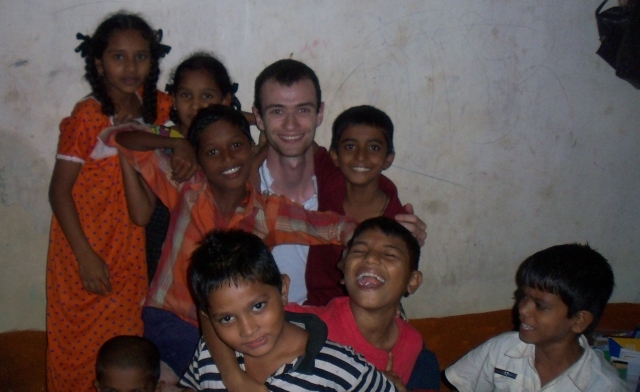This is India

In 2010, Scott Leslie left the UK to take part in a voluteering project in India. Here he discovered the stark contrast between the super rich and those living in the slums, and the power of two cultures coming together.
Two years ago, glancing out of the window as my plane began its descent towards Mumbai, I got my first tastes – both literal and metaphorical – of life on the Indian subcontinent. The first, a surprisingly delicious lamb curry that would be my first of two in-flight lunches that day, was admittedly a somewhat pre-packaged and processed affair; an altogether inadequate precursor to the dishes that would exquisitely batter my taste buds in the course of the next two months. The second, however, was disarmingly raw; the sea of blue tarpaulin which spread uninterrupted in all directions beneath me, illustrated in no uncertain terms that life for many in this vast metropolis, was a far cry from the one that most of us on this plane would be used to. In their attempts to guard their homes against a deluge of monsoon rains, the residents of Mumbai’s vast slums also seemed to send out a message: ‘we’re down here; you’re up there; this is India’.
It is the notion of India as ‘a world of contrasts’ that, for all its woeful vagueness, is probably the only way in which to concisely do justice to a country that is, in reality, ‘a world within itself’. It is a world in which the rich and super rich rub shoulders with the poor and desperately impoverished; in which movie stars and business entrepreneurs contribute equally to what is one of the fastest emerging commercial markets in the world; perhaps most fascinatingly, it’s also a world in which tradition and modern identity seem to fight it out on the streets, in people’s homes, in people’s clothes, and always in the most unexpected ways.
I passed through Mumbai, rather unceremoniously making my way between one airport terminal and another, on my way to Goa, a state which in many ways epitomises the divide between opulence and poverty. There, all-inclusive resorts have been annexed onto small, former fishing villages in which life, even for those whose new careers centre on a burgeoning tourism market, often remains drastically removed from the luxury and indulgence that visitors enjoy. In one such area, I was to spend two months volunteering as part of a project which operates alongside schools, orphanages and healthcare centres that would otherwise struggle to provide essential services for the people that rely on them. By organising the involvement of mainly Western volunteers, the scheme also facilitates the exchange of cultures, ideas and stories, and would give me the chance to meet and connect with the individuals who are so often left behind by tales of ballooning economies, dazzling movie industries and pioneering technology.
Two days after stepping off the plane, I stood in front of a class of around fifteen children aged (I guessed) between seven and nine. All of them lived in a hill-top slum just outside the city of Margao, and attended this government-run primary school situated on the community’s lower outskirts. Within feet of the classroom door began a row of mansion houses, dotted along the roadside, all with stunning views of the city below. A large pile of waste, a playground for stray dogs and children alike, marked the entrance to the slum and showed just how quickly one can cross the divide between one reality and another. Inside, the children of my class sat at their desks in uniforms of faded blue, staring keenly at me. Their bright faces seemed to tell a completely different story to the one I’d imagined when glancing up the puddle-dotted, litter-strewn streets that they called home. One of the project leaders, Cynthia, instructed them all to welcome us, which they did with a sing-song ‘welcome, teacher!’ It was at this point that I realised how many times they all must have gone through this same routine. I wondered, with sudden nervousness, if the work that we would do here would have any lasting impact at all.
That same afternoon, I entered another classroom, this time to lead an after-school learning club which operated from inside the home of one of the children’s families. It was here in this tiny room, surrounded by the laughter and exuberance of the children, and the endlessly welcoming attitudes of the adults, that I realised that the purpose of this project was not about making change.
It was about both cultures coming together in order to explore the value of what was already there. Across eight weeks I got to know these children more, and realised that their happiness, their passion for learning and for play, outstripped anything I had ever encountered in the children I knew from home. I was struck also by the openness of the local people, who let virtual strangers enter their homes, thereafter forging links with them; people, like me, who had travelled from a world away. It dawned on me that with just a little effort, the balance (or imbalance) I had first perceived in India, could fundamentally shift; they were here, I was here too, and that is India.
Have you had a life-changing trip? Get in touch at liremagazine@gmail.com and you could be featured!



